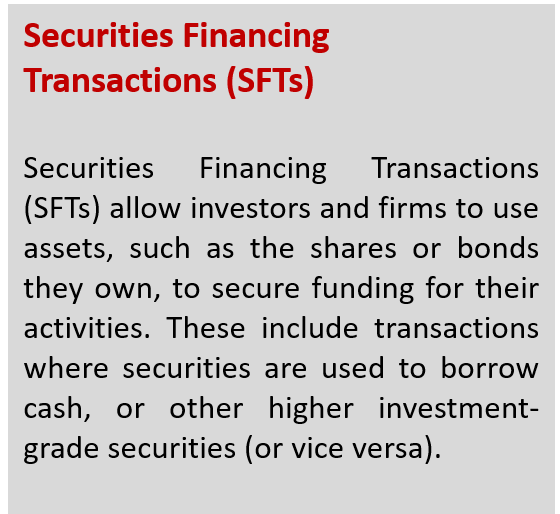Learning From Experience
After the global financial crisis in 2008, international bodies including the Financial Stability Board (FSB) and European Systemic Risk Board (ESRB) identified significant gaps in the regulatory frameworks implemented in the financial systems around the world and highlighted the need to improve transparency in the traditional banking system as well as the shadow banking system that had grown to enormous proportions.
Pre-crisis, the shadow banking intermediaries distinguished themselves from the banks by not accepting traditional deposits. As a result, many of these institutions had been able to pursue higher market, credit, and liquidity risks in their lending while lacking the capital requirements to balance those risks. Components of the Shadow Banking system encompasses securitization vehicles, asset-backed commercial paper conduits, money market funds, markets for repurchase agreements, investment banks, and mortgage companies.
Following the recommendation by the FSB and ESRB to mitigate the inherent risks in shadow banking and increase transparency, the European Commission, as part of the roadmap under the post-crisis G20 commitments, released several regulations such as European Market Infrastructure Regulation (EMIR), Markets in Financial Instruments Directive (MiFID II) as well as the recently published Securities Financing Transactions Regulation (SFTR).
Achieving Compliance
SFTR is aimed at bringing greater transparency to the securities financing and repo markets. By mandating Security Financing Transactions (SFTs) reporting to a central repository in a standardized way, regulators are attempting to gain new insights into potential systemic risks and to look for indicators to avoid future crises.
Through SFTR, regulators have implemented a two-pronged approach whereby they are attempting to:
I. Evaluate how firms currently capture and book positions going through the securities lending process
II. Track the chain of collateral movements (including financial instruments as collateral) and its reuse
As part of the FSB framework, in scope entities are required to create and send reports to Financial Conduct Authority (FCA) via an approved Trade Repository on a Trade Date+1 basis (or settlement+1 basis). To implement the FSB framework, the European Parliament published SFTR (EU 2015/2365)[1] in 2016. SFTR is due for implementation in four phases beginning from April 11th 2020. European Securities & Markets Authority (ESMA)[2], via SFTR, will regulate securities financing activities by setting out reporting requirements, data access, collection, verification, aggregation, comparison and publication of data by Trade Repositories (TRs) on SFTs such as:
Repurchase agreements (repos)
Securities lending
A buy-sell back transaction or sell-buy back transaction
Margin lending
SFTR is a key piece of the legislation focused on evaluating reported transactions (SFTs, associated transaction details, margin, etc.), collateral re-use as well as counterparty information (jurisdiction, counterparty and criteria used, security details, collateral valuation methodology, etc.) for all in-scope entities.
Impacted parties include financial counterparties (or branches) established (and engaged in reuse) in the European Economic Area (EEA), banks, investment firms, Central Counterparty Clearing (CCPs), Central Security Depository (CSDs), insurance, reinsurance undertakings, pension funds, Undertakings for the Collective Investment in Transferable Securities (UCITs), Alternate Investment Funds (AIFs) and non-financial counterparties.
Key similarities between EMIR and SFTR include reporting eligibility criteria and requirements, approach to collecting reference data, obligation to report to a trade repository by T+1 and record keeping requirement for the transactions for minimum 5 years following trade termination. Like EMIR for derivatives reporting, SFTR establishes that both parties to a trade need to report new, modified or terminated SFTs to a registered or recognized TR on a T+1 basis.
Although strikingly similar to European Market Infrastructure Regulation (EMIR) recently implemented by financial organizations, SFTR varies significantly in its scope (focused on SFTs) and asset classes. Additionally, SFTR also requires reconciliation of reported transactions.
Preparing for the Challenges
Challenges remain in implementing SFTR for in-scope financial institutions such as:
Data sourcing from multiple systems presents a challenge across large organizations to extract all the required fields. (Increased required number of fields, content and structure of data collected. 129 fields in EMIR vs. 153 fields in SFTR)
Reporting challenges may arise due to re-use of collateral securities (also known as rehypothecation) in other SFTs leading in complex collateral chains. Also, limitations of booking and reporting tools pose a risk of inaccuracy of data.
Pre-matching/reconciliation poses an operational challenge as it requires generation of identifiers (Legal Entity Identifier (LEI) & Unique Trade Identifiers (UTIs)), resolution and validation within the stipulated time as well as streamlining of multiple data sources across vendors/platforms. As per the regulation, reconciliation of each SFT reported with other firm's submissions is required. (The process of two parties sending their portfolio of messages into a platform for a reconciliation prior to reporting to the trade repository (TR)).
Moving Forward
SFTR is in essence a reporting requirement, however, it fundamentally targets to change the whole post-trade execution process. It attempts to bring more transparency by forcing firms to introduce trade confirmation matching platforms, establish trading and booking standards as well as improve data quality and consistency to see the bigger picture. While Europe has taken a step further in its commitment to post-crisis reforms in the region, US has not yet adopted a comprehensive securities financing regulation. However, it may only be a matter of time before US regulators, and indeed others, do so.
Why Monticello?
Monticello Consulting Group assists clients across the financial services industry in implementing the necessary infrastructure to ensure compliance and reduce regulatory risks. This experience, coupled with our deep understanding of this regulation’s intricacies and complexities, uniquely positions Monticello to guide financial institutions in the adoption and implementation of the Securities Financing Transactions Regulation.
[1] https://eur-lex.europa.eu/legal-content/EN/TXT/PDF/?uri=CELEX:32015R2365&from=EN
[2] https://www.esma.europa.eu/policy-activities/post-trading/sftr-reporting
Get In Touch
LEARN MORE ABOUT MONTICELLO AND PURSUE OPPORTUNITIES WITH OUR TEAM
Manager






